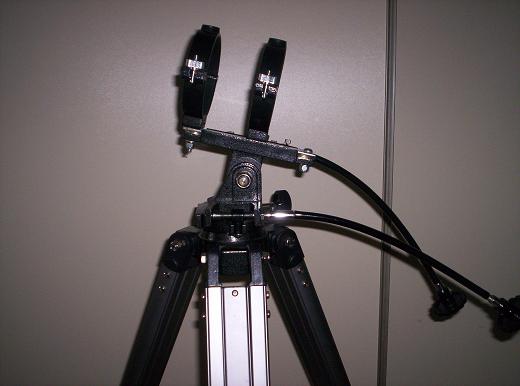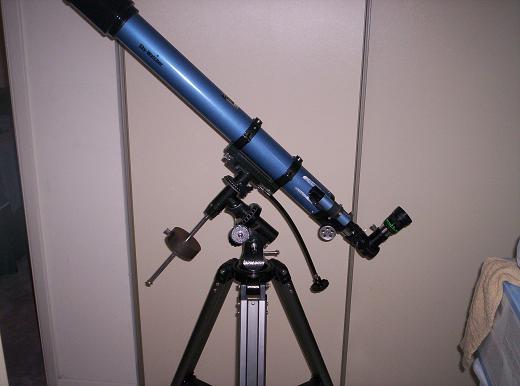
MOUNTS
ALTITUDE/AZIMUTH vs EQUATORIAL


LEFT: Synta AZ3 mount. RIGHT: Synta EQ2 mount.
There are 2 basic types of mounts available for telescopes: Altitude/Azimuth (also called Altazimuth and Alt/Az) and Equatorial. Altazimuth mounts are designed for simple left/right, and up/down operation. Equatorial mounts operate in a different manner that better corresponds to the individual observers location and the rotation of the Earth as related to the sky. Each type of mount has it's advantages and drawbacks. For this comparison I have chosen 2 common entry level mounts that I own myself and am quite familiar with. They are/were supplied as standard equipment on telescopes sold under brand names such as Skywatcher, Celestron and Orion to name a few.
ALTITUDE/AZIMUTH MOUNTS

Synta AZ3 mount on standard aluminum tripod
+
The AZ3 mount shown in this photo came with my 4" Skywatcher shorttube refractor. The telescope just balances like a rotatable teeter-totter on top of a set of adjustable legs. There are no hand knobs to loosen and tighten as you aim the telescope. Once it is balanced on the mount you just push the tube to where you want to point it. There are 2 manual fine tuning controls on long flexible sticks you can then turn to get the aim just right. These mounts are perfect for daytime land viewing using refractor telescopes. With the use of a mirror diagonal you get views that are right side up, and using an erecting prism they are oriented correctly like in a pair of binoculars.
To set up an altazimuth mount, you simply spread the tripod legs and adjust them to a convenient height with tripod level to the ground. You can rotate the telescope to point east, west, etc. You can also raise and lower the aim closer and farther away from the horizon.

4" shorttube refractor on AZ3 mount
These mounts are great for scanning the horizon or observing wildlife on the ground, but they are sometimes not ideal for astronomical purposes. If you examine the photos above, you might notice that the tube ring towards the viewing end of the telescope has been modified where it joins the mount. I have moved it closer to the center of the tripod so I can slide the optical tube farther forward and make it a little top-heavy. This is necessary when aiming the telescope high to keep it from falling backwards.
If you look at the way the telescope is balanced on the mount, you will notice that as you aim the telescope higher, the weight of it shifts behind it's center of gravity. If you go high enough, the weight of the tube makes it fall back and point straight up. The only way to counteract this would be to tighten the main bolt at that pivot point, but that would make the telescope difficult to move. Even with the tube slid as far forward as it will go on my modified mount, the weight of a 27 Panoptic is pushing the limit when it comes to staying stationary pointing close to the zenith.
EQUATORIAL MOUNTS

Synta EQ2 mount on standard aluminum tripod
The Equatorial mount is geared specifically towards astronomical use. Instead of using the zenith and horizon as a reference points, they use the gallactic poles of the Earth's sky. These are the points directly above the Earth's spinning axis that never change their position from the viewer's location, and which the entire night sky seems to rotate around as the hours pass by. In the northern hemisphere this point is very close to Polaris (the north star). It is the end star on the handle of the "Little Dipper" in Ursa Minor. At my location Polaris is towards the north roughly 44 degrees above the horizon.
Since the planes of axis for the telescopes motion are centered around the gallactic pole, the telescope doesn't aim up/down and left/right anymore. These 2 planes of reference are now called declination and right ascention. Declination is how far in angular degrees, minutes, and seconds the location is from the gallactic equator. Right ascention refers to the equivalent of longitude on the Earth as it applies to the sky, and is measured in hours, minutes, and seconds. Unlike longitude, the units of measurement do not start at one line of reference and go in opposite directions until they meet 180 degrees from the base line (east and west). Instead the reference line starts at 0 hours, and goes one way around the gallactic globe with each 15 degrees of angular travel equalling one hour. In other words, if you go around 360 degrees, that translates into 24 hours of right ascention. This makes the system universal for locating objects anywhere on Earth by their co-ordinates concerning objects far out in space.


LEFT: Synta EQ2 mount with 70mm longtube refractor.
RIGHT: Close-up of head angled for 44 degrees latitude.
By looking at the Equatorial mount shown above, you can immediately notice 2 things that are different that an Altazimuth mount. For one thing, the mount seems angled as compared to the ground. That is because it's operation centers around the gallactic pole, and the 2 axis of motion must be lined up accordingly for the observer's location in order to work properly. To do this you must level the tripod, and adjust the angle of the mount to match your latitude. In my case it is 44 degrees, so the mount must be angled upwards of the level horizon to match that amount. Since I am in the northern hemisphere, I aim towards the north gallactic pole (near polaris), and the mount is now polar aligned. That is the basic concept, but there is a lot more to it when it comes to polar aligning accurately enough to use co-ordinates as a means of locating an object, or to aim a mount for the purpose of motorized tracking.
You may notice that there is also a counterweight on the mount. This is due to the nature of the mount, and the fact that the telescope will sometimes be beside the mount as it relates to the horizon in order to aim in certain directions. The counterweight is necessary to keep the tube from falling downwards as it would when aiming high with an Altazimuth mount. There are also locking screws on an Equatorial mount that will keep the telescope aimed. The tube should be balanced enough to remain stationary when you let go of the tube, but you must tighten these knobs to ensure the operation of the fine tuning adjustments for the aim, as well as any motorized drives for tracking the mount might have.
Equatorial mounts work great for observing the sky at night. Since the tube is balanced, I can put my shorttube refractor on my EQ2 mount with even a 41mm Panoptic or a 31mm Nagler eyepiece and it can be aimed in any direction without falling. If an object moves as the Earth rotates, you can re-center it by adjusting the fine tuning for the right ascention only, as it's declination hasn't changed. The motor for a mount that tracks objects on an auto-driven mount is connected to the right ascention drive, and simply turns it slow enough to keep an object centered. With an Altazimuth mount, you usually have to adjust both fine tuners to re-center an object that has moved out of view.
Equatorial mounts are not very useful for daytime viewing on land though. It's hard to describe the way a telescope moves on an Equatorial mount as you try to aim it. It can turn almost upside-down and could be in any position in relation to the tripod depending on where you're aiming. At times you must rotate, flip, and spin the telescope to aim from one part of the sky to another. I like to call this series of motions "the Equatorial Tango". Let's pretend you had a telescope set up on a lakeshore and wanted to scan the other side of the lake. Using an Equatorial mount, you aim straight across the lake and adjust your diagonal to place the eyepiece in a convenient location for viewing. As you try to scan along the opposite shoreline you must rotate the scope on both axis', and the orientation of the view changes. If you scan one way the view tilts farther to the right, and as you scan the other it tilts farther to the left. This can be corrected by rotating the diagonal and the tube on the rings, but it is a pain in the butt and can turn a relaxing nature viewing session into a frustrating exercise in patience.
-----------------------








